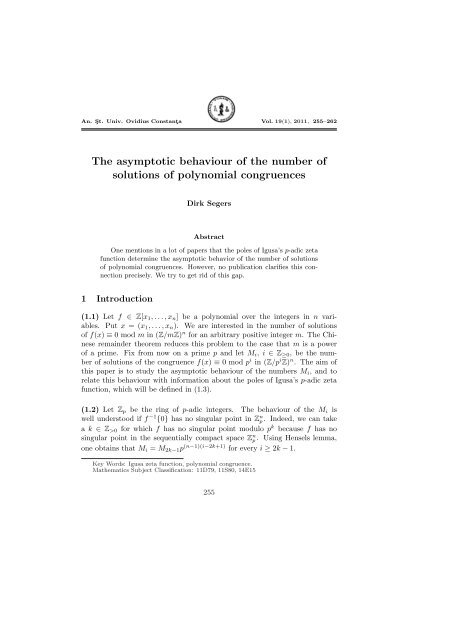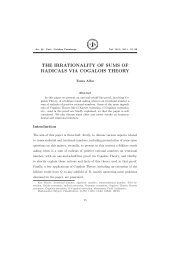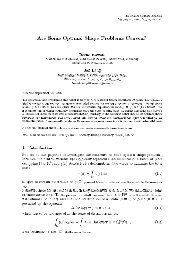The asymptotic behaviour of the number of solutions of polynomial ...
The asymptotic behaviour of the number of solutions of polynomial ...
The asymptotic behaviour of the number of solutions of polynomial ...
Create successful ePaper yourself
Turn your PDF publications into a flip-book with our unique Google optimized e-Paper software.
<strong>The</strong> <strong>asymptotic</strong> <strong>behaviour</strong> <strong>of</strong> <strong>the</strong> <strong>number</strong> <strong>of</strong> <strong>solutions</strong> <strong>of</strong> <strong>polynomial</strong>... 257where B(t) ∈ S[t]. Here, B(t) is also not divisible by any <strong>of</strong> <strong>the</strong> 1 − p −ν jt N j.<strong>The</strong> poles <strong>of</strong> P (t) and Z f (t) are actually <strong>the</strong> same.(1.5) In this paper, we try to explain <strong>the</strong> relation between <strong>the</strong> poles (and <strong>the</strong>irorder) <strong>of</strong> P (t), which are <strong>the</strong> same as those <strong>of</strong> Z f (t), and <strong>the</strong> <strong>number</strong>s M i . Ifalso <strong>the</strong> principal parts <strong>of</strong> <strong>the</strong> Laurent series <strong>of</strong> P (t) at all poles are known, wewill even calculate <strong>the</strong> <strong>number</strong>s M i (and not only <strong>the</strong>ir <strong>asymptotic</strong> <strong>behaviour</strong>)for i large enough. <strong>The</strong> principal parts <strong>of</strong> <strong>the</strong> Laurent series <strong>of</strong> Z f (t) and P (t)at a certain pole can be calculated from each o<strong>the</strong>r, which is also <strong>the</strong> casefor <strong>the</strong> ones <strong>of</strong> Z f (s) and Z f (t) at corresponding poles. <strong>The</strong>refore, it is alsopossible to calculate <strong>the</strong> <strong>number</strong>s M i for i large enough from <strong>the</strong> principalparts <strong>of</strong> <strong>the</strong> Laurent series <strong>of</strong> Z f (s) at all its poles. This will not be workedout in <strong>the</strong> paper because it leads to formulas which are more complicated andwhich do not give us more insight.Reference. An introduction to Igusa’s p-adic zeta function which containsmore details can be found in [Se1, Section 1.1], [Ig2] or [De].Acknowledgements. I want to thank Pierrette Cassou-Noguès for pointing myattention at this problem.2 <strong>The</strong> <strong>asymptotic</strong> <strong>behaviour</strong>(2.1) We define an equivalence relation on J. We say that j 1 ∼ j 2 iff ν j1 /N j1 =ν j2 /N j2 . This equivalence relation determines a partition <strong>of</strong> J into sets J k ,k ∈ V . For k ∈ V , we denote <strong>the</strong> lowest common multiple <strong>of</strong> <strong>the</strong> ν j , j ∈ J k ,by a k and <strong>the</strong> lowest common multiple <strong>of</strong> <strong>the</strong> N j , j ∈ J k , by b k . Remarkthat a k /b k = ν j /N j for all j ∈ J k . Let m k be <strong>the</strong> cardinality <strong>of</strong> J k . Because1 − p −a kt b kis a multiple <strong>of</strong> 1 − p −νj t Nj for all j ∈ J k , we can writewhere C(t) ∈ S[t].P (t) =C(t)∏k∈V (1 − p−a k tb k) m k,<strong>The</strong>orem. <strong>The</strong>re exists a unique decomposition <strong>of</strong> every M i with i > deg(P (t))<strong>of</strong> <strong>the</strong> formr∑M i = g k (i)p lki ,k=1where <strong>the</strong> l k are different rational <strong>number</strong>s and where every g k (i) is a nonzer<strong>of</strong>unction which is <strong>polynomial</strong> with rational coefficients on residue classes. <strong>The</strong>
258 Dirk Segersr <strong>number</strong>s l k − n are <strong>the</strong> real parts <strong>of</strong> <strong>the</strong> poles <strong>of</strong> Z f (s). If we denote <strong>the</strong>elements <strong>of</strong> V by 1, . . . , r in such a way that l k − n = −a k /b k for everyk ∈ {1, . . . , r}, we have for k ∈ {1, . . . , r} that1. <strong>the</strong> function g k (i) is <strong>polynomial</strong> on each residue class modulo b k ,2. <strong>the</strong> maximum <strong>of</strong> <strong>the</strong> degrees <strong>of</strong> <strong>the</strong>se <strong>polynomial</strong>s is equal to m k − 1 and3. <strong>the</strong>se <strong>polynomial</strong>s (and thus also g k (i)) are determined by <strong>the</strong> principalparts <strong>of</strong> <strong>the</strong> Laurent series <strong>of</strong> Z f (s) in <strong>the</strong> poles with real part −a k /b k .Remark. (1) <strong>The</strong> l k are rational <strong>number</strong>s less than n because <strong>the</strong> real parts <strong>of</strong><strong>the</strong> poles <strong>of</strong> Z f (s) are negative rational <strong>number</strong>s. <strong>The</strong> author proved in [Se3]that <strong>the</strong> real part <strong>of</strong> every pole <strong>of</strong> Z f (s) is larger than or equal to −n/2. Thisimplies that l k ≥ n/2 for every k ∈ {1, . . . , r}. Moreover, in <strong>the</strong> case thatn = 3 and f has no singular point in Z 3 p <strong>of</strong> multiplicity 2, <strong>the</strong> author proved[Se2] that <strong>the</strong>re are no poles with real part less than −1, which implies thatl k ≥ 2 for every k ∈ {1, . . . , r}.(2) It follows from <strong>the</strong> <strong>the</strong>orem that <strong>the</strong> <strong>asymptotic</strong> <strong>behaviour</strong> <strong>of</strong> <strong>the</strong> <strong>number</strong><strong>of</strong> <strong>solutions</strong> is determined by <strong>the</strong> largest real part <strong>of</strong> a pole <strong>of</strong> Z f (s) andby <strong>the</strong> largest order <strong>of</strong> a pole with maximal real part.Pro<strong>of</strong>. Applying decomposition into partial fractions in Q[t], we can writeP (t) = C 0 (t) + ∑ k∈VC k (t)(1 − p −a k tb k) m k,where every C k (t) ∈ Q[t] and where deg(C k (t)) < m k b k for k ∈ V . Note that<strong>the</strong> term C 0 (t) does not give a contribution to M i for i > deg(C 0 (t)) and thatdeg(C 0 (t)) = deg(P (t)) if one <strong>of</strong> <strong>the</strong>m is non-negative. Now we look at <strong>the</strong>contributions <strong>of</strong> <strong>the</strong> o<strong>the</strong>r terms. So fix k ∈ V . Note that C k (t) containsexactly <strong>the</strong> information <strong>of</strong> <strong>the</strong> principal parts <strong>of</strong> <strong>the</strong> Laurent series <strong>of</strong> P (t) at<strong>the</strong> poles with absolute value p a k/b k. We haveC k (t)(1 − p −a k tb k) m k===C k,mk (t) C k,mk −1(t)(1 − p −a +k tb k) m k (1 − p −a k tb k) m k −1 + · · · + C k,1(t)1 − p −a k tb kb∑k −1 ∞∑g k,d (e)p −ea kt eb k+dd=0 e=0b∑k −1d=0 e=0∞∑g k,d (e)p da k/b k p (n−a k/b k )(eb k +d) teb k+dp ,n(eb k+d)
<strong>The</strong> <strong>asymptotic</strong> <strong>behaviour</strong> <strong>of</strong> <strong>the</strong> <strong>number</strong> <strong>of</strong> <strong>solutions</strong> <strong>of</strong> <strong>polynomial</strong>... 259where C k,l (t) ∈ Q[t] with deg(C k,l (t)) < b k and where <strong>the</strong> maximum <strong>of</strong> <strong>the</strong>degrees <strong>of</strong> <strong>the</strong> <strong>polynomial</strong>s g k,d (e) is equal to m k − 1. Actually, if we denote<strong>the</strong> coefficient <strong>of</strong> t d in C k,l (t) by C k,l,d , we get(e + m k − 2)!g k,d (e) = C k,mk ,d(e − 1)!(m k − 1)! +C (e + m k − 3)!k,m k −1,d(e − 1)!(m k − 2)! +· · ·+C k,1,d.□(2.2) Finally, we give two examples. In <strong>the</strong> first example, all <strong>the</strong> coefficients<strong>of</strong> <strong>the</strong> <strong>polynomial</strong>s C k (t), k ∈ V , are in S. This is in some sense <strong>the</strong> easiestsituation. <strong>The</strong> second example shows that this is not always <strong>the</strong> case. <strong>The</strong>reare several ways to compute <strong>the</strong> Poincaré series: one can calculate <strong>the</strong> integralon an embedded resolution <strong>of</strong> singularities <strong>of</strong> f, one can use <strong>the</strong> formula for<strong>polynomial</strong>s which are non-degenerated over F p with respect to <strong>the</strong>ir Newtonpolyhedron [DH] and one can use <strong>the</strong> p-adic stationary phase formula [Ig2,<strong>The</strong>orem 10.2.1]. All <strong>the</strong>se techniques are also explained in [Se1, Section 1.1].Example 1. Let f(x, y) = y 2 − x 3 and let p be an arbitrary prime. <strong>The</strong>n,P (t) = −t6 + p 4 t 2 − p 3 t 2 + p 6(p 5 − p 6 )(p − t)= 2p−5 t 5 + 2p −4 t 4 + 2p −3 t 3 + 2p −2 t 2 + (p + 1)p −2 t + (p + 1)p −11 − p −5 t 6= − p−11 − p −1 t .We obtain for every e ∈ Z ≥0 thatM 6e = (p + 1)p 7e−1 − p 6e−1 , M 6e+1 = (p + 1)p 7e − p 6e ,M 6e+2 = 2p 7e+2 − p 6e+1 , M 6e+3 = 2p 7e+3 − p 6e+2 ,M 6e+4 = 2p 7e+4 − p 6e+3 and M 6e+5 = 2p 7e+5 − p 6e+4 .Example 2. Let f(x, y) = x 3 + y 5 and let p be an arbitrary prime. <strong>The</strong>n,P (t) ==−t 15 + (p − 1)t 14 + (p − 1)pt 12 + (p − 1)p 3 t 9+(p − 1)p 3 t 8 + (p − 1)p 5 t 5 + (p − 1)p 6 t 3 + (p − 1)p 6 t 2 + p 9(p 8 − t 15 )(p − t)C 1 (t)1 − p −8 t 15 + C 2(t)1 − p −1 t ,
260 Dirk SegerswhereC 1 (t) = p7 + p − 2(p 7 − 1)p 8 t14 + p7 + p 2 − p − 1(p 7 − 1)p 8 t 13 + p7 + p 2 − p − 1(p 7 − 1)p 7 t 12 +and+ p7 + p 3 − p 2 − 1(p 7 − 1)p 7 t 11 + p7 + p 3 − p 2 − 1(p 7 − 1)p 6 t 10 + p7 + p 3 − p 2 − 1(p 7 − 1)p 5 t 9 ++ p7 + p 4 − p 3 − 1(p 7 − 1)p 5 t 8 + p7 + p 5 − p 4 − 1(p 7 − 1)p 5 t 7 + p7 + p 5 − p 4 − 1(p 7 − 1)p 4 t 6 ++ p7 + p 5 − p 4 − 1(p 7 − 1)p 3 t 5 + p7 + p 6 − p 5 − 1(p 7 − 1)p 3 t 4 + p7 + p 6 − p 5 − 1(p 7 − 1)p 2 t 3 ++ 2p7 − p 6 − 1(p 7 − 1)p 2 t2 + p8 − 1(p 7 − 1)p 2 t + p8 − 1(p 7 − 1)pC 2 (t) = − p − 1(p 7 − 1)p .As an illustration, we calculate <strong>the</strong> M i for i in <strong>the</strong> residue class <strong>of</strong> 3 modulo15:M 3+15e = (p7 + p 6 − p 5 − 1)p 4+22ep 7 − 1−(p − 1)p2+15ep 7 − 1(1)= p 4+22e +(p − 1)p9+22ep 7 − 1−(p − 1)p2+15ep 7 − 1= p 4+22e + (p − 1) p7e+7 − 1p 7 − 1p2+15e= p 4+22e + (p − 1)(p 7e + · · · + p 14 + p 7 + 1)p 2+15e .Note that <strong>the</strong> two terms in (1) are not integers and that one <strong>of</strong> <strong>the</strong>m is negative.Note also that <strong>the</strong> Poincaré series in <strong>the</strong> two examples are rational functions<strong>of</strong> t and p, but this is not <strong>the</strong> case in general.AcknowledgmentPostdoctoral Fellow <strong>of</strong> <strong>the</strong> Fund for Scientific Research - Flanders (Belgium).<strong>The</strong> author is supported by FWO-Flanders project G.0318.06.References[De]J. Denef, Report on Igusa’s local zeta function, Sém. Bourbaki 741, Astérisque201/202/203 (1991), 359-386.
<strong>The</strong> <strong>asymptotic</strong> <strong>behaviour</strong> <strong>of</strong> <strong>the</strong> <strong>number</strong> <strong>of</strong> <strong>solutions</strong> <strong>of</strong> <strong>polynomial</strong>... 261[DH] J. Denef and K. Hoornaert, Newton Polyhedra and Igusa’s Local Zeta Function, J.Number <strong>The</strong>ory 89 (2001), 31-64.[Hi]H. Hironaka, Resolution <strong>of</strong> singularities <strong>of</strong> an algebraic variety over a field <strong>of</strong> characteristiczero, Ann. Math. 79 (1964), 109-326.[Ig1] J. Igusa, Some observations on higher degree characters, Amer. J. Math. 99 (1977),393-417.[Ig2][Se1]J. Igusa, An Introduction to <strong>the</strong> <strong>The</strong>ory <strong>of</strong> Local Zeta Functions, Amer. Math. Soc.,Studies in Advanced Ma<strong>the</strong>matics 14, 2000.D. Segers, Smallest poles <strong>of</strong> Igusa’s and topological zeta functions and <strong>solutions</strong> <strong>of</strong><strong>polynomial</strong> congruences, Ph.D. <strong>The</strong>sis, Univ. Leuven, 2004.Available on http://wis.kuleuven.be/algebra/segers/segers.htm[Se2] D. Segers, On <strong>the</strong> smallest poles <strong>of</strong> Igusa’s p-adic zeta functions, Math. Z. 252(2006), 429-455.[Se3][SV]D. Segers, Lower bound for <strong>the</strong> poles <strong>of</strong> Igusa’s p-adic zeta functions, Math. Ann.336 (2006), 659-669.D. Segers and W. Veys, On <strong>the</strong> smallest poles <strong>of</strong> topological zeta functions, CompositioMath. 140 (2004), 130-144.K.U.Leuven, Departement Wiskunde, Celestijnenlaan 200B, B-3001 Leuven,Belgium,http://wis.kuleuven.be/algebra/segers/segers.htme-mail: dirk.segers@wis.kuleuven.be
262 Dirk Segers






